When I first observed turtles, I noticed how their vast range of colors and patterns often reveal more than just beauty—they indicate survival strategies. A common shell may appear green, brown, black, or gray, but subtle yellow, orange, red, or cream markings transform these earthy shades into signals of adaptation. People often assume muted tones like brownish-gray, caramel, tan, or dark brown mean dullness, yet such variations between species, habitat, or even a single subspecies reflect hidden complexity.
Over time, I’ve seen some sea turtles gliding with olive-green shells, others basking in greenish-brown, while freshwater species flash brighter tones with striped or spotted patterns. Strangely, I once recorded individuals showing rare blue, purple, or pink surfaces—proof that diversity doesn’t always follow predictable lines. Whether black, white, or olive green, these creatures embody how environment and evolution merge to create a palette as dynamic as nature itself.
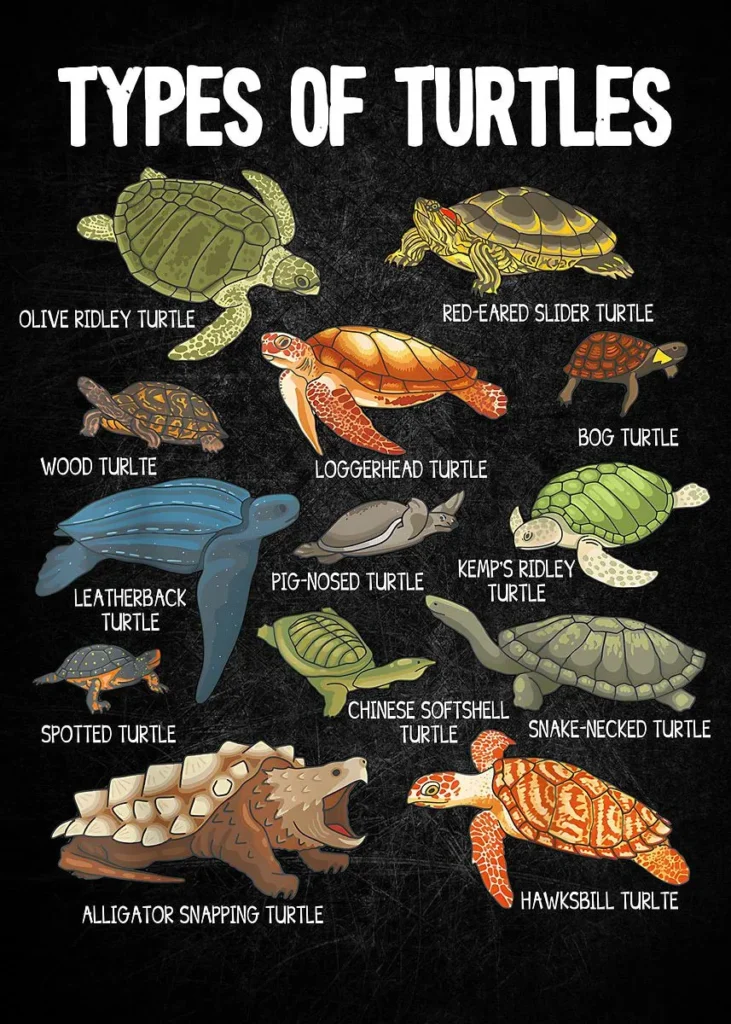
Common Land and Freshwater Turtles (What Colors Are Turtles)
Many land and freshwater turtles I’ve encountered had shells with shades of brown, green, or black, sometimes streaked with spots, stripes, or even swirls. Observing them closely, the subtle balance between camouflage and attraction becomes clear: a semi-aquatic turtle shimmering in bright green beside one carrying yellow highlights across its skin or shells.
From my field notes, younger turtles often reveal brighter surfaces with occasional red, orange, or pink hues scattered like paint across their carapaces. These colors may appear random, but each shade has ecological meaning—some blend against mud, others stand out during mating.
Sea Turtles
Across coasts, species of sea turtles shift hues over time. While adults usually show deeper olive-green, greenish-brown, or reddish-brown, hatchlings start almost black, their scales and scutes shimmering in intricate patterns that shimmer under waves. I’ve handled rescued turtles where the play of yellow along the edges created mosaics unlike anything seen in land reptiles.
Sometimes, these patterns serve less as camouflage and more as signatures of genetic variety. A black carapace lined with faint streaks demonstrates how a turtle’s history—its migration and feeding zones—gets written across its back like a map of survival.
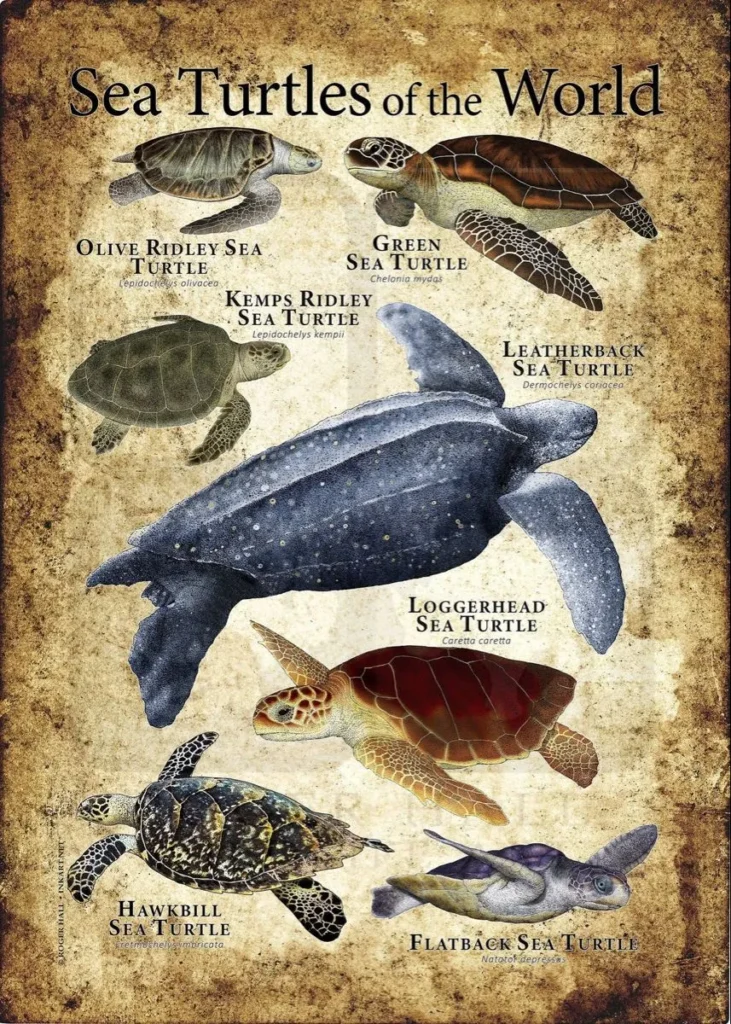
Diamondback Terrapin
Among the most surprising are diamondback terrapins, where variable appearance defines entire populations. In a single clutch, I’ve seen individuals with glowing light or white skin, others closer to cream, some leaning toward dark gray, and rare ones displaying bluish or purplish skin tones. Their shells often carry unique speckled, even diamond-like patterns, creating a gallery of natural artistry.
Leatherback Sea Turtle
Unlike others, leatherbacks are marked by black shells and lighter plastrons—their bottom shells often decorated with white or grayish splotches. I once ran my hand across the leathery carapace, noticing how different it felt from hard-shelled turtles, the distinctive surface reflecting millions of years of separate evolution.
Factors Influencing Turtle Colors
When studying coloration, camouflage remains central. Whether blending into rivers, forests, or oceans, turtles use colors to achieve protection from predators. At the same time, species and subspecies differences influence specific color patterns, linking to evolutionary adaptation shaped by environment.
But even within one population, individual variation emerges. I’ve examined hatchlings showing different hues due to genetic diversity, proving that survival is not only about adaptation but also about maintaining enough variety for future resilience.
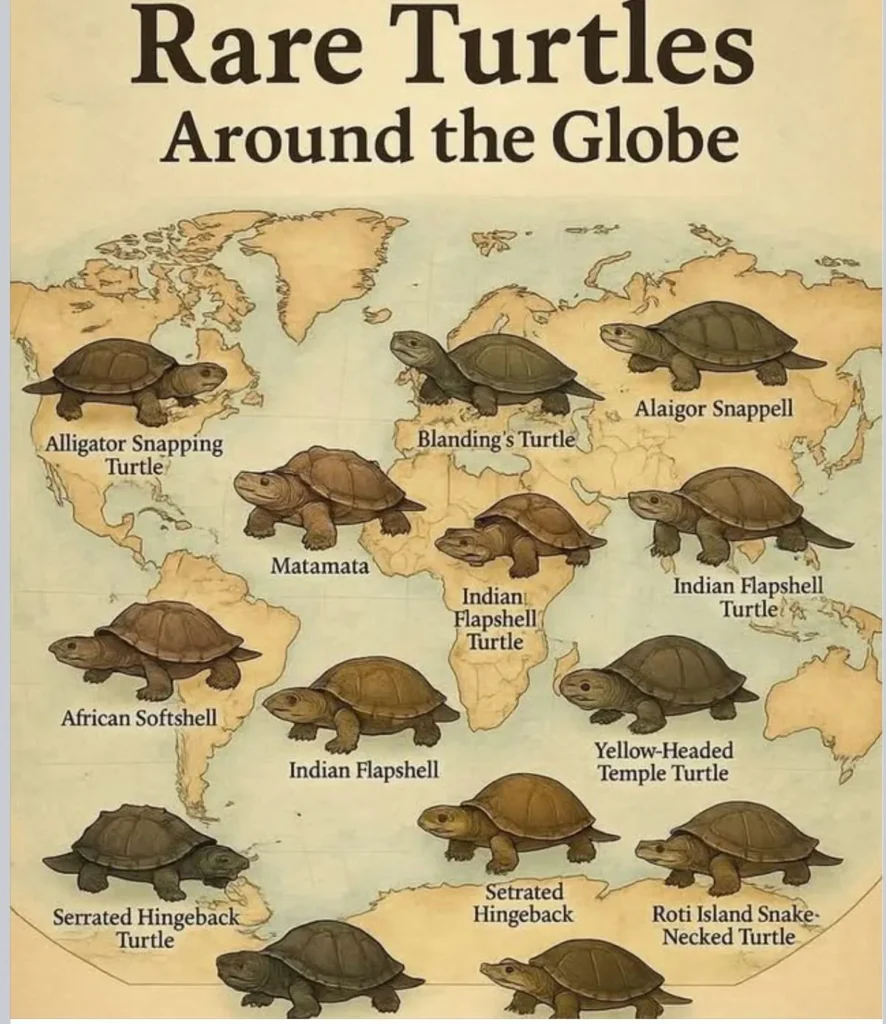
Rare Turtle Colors
Though rare and often uncommon, I have observed turtles with shades of blue, purple, and pink. Sometimes linked to genetic mutations or unusual pigmentation variations, such appearances are not merely curiosities—they become prized subjects for enthusiasts and researchers who document natural rarity.
Turtle Skin Colors
A turtle’s skin can range widely, from gray, olive, dark green, brown, or occasional bluish and purplish hues, depending on species. In some cases, like painted turtles, I’ve noticed striking yellow or red stripes across the skin, blending vividness with utility.
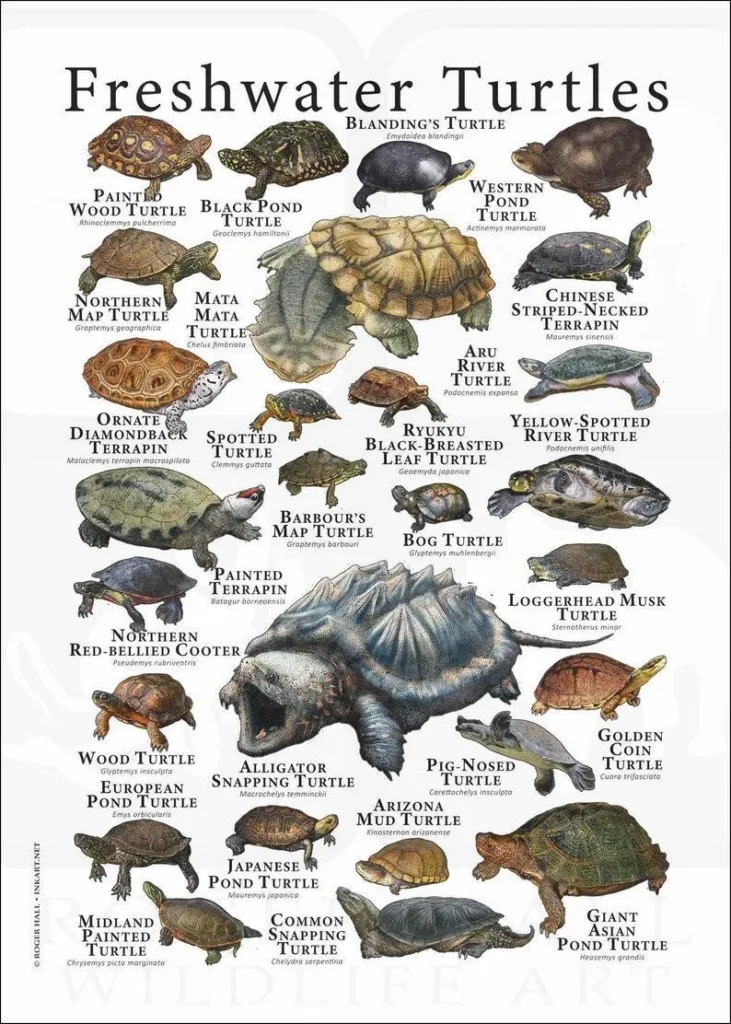
FAQs About Turtle Colors
Q: What colors are most common in turtles?
Most turtles are green, brown, black, or gray, often with yellow or orange markings. These colors help them blend into their natural environments like rivers, forests, and oceans.
Q: Do turtles only come in green and brown colors?
No, while many turtles are green or brown, others may appear black, white, tan, olive, reddish-brown, or even cream. Some freshwater turtles also display red, orange, or bright yellow highlights.
Q: What color is a turtle’s shell usually?
A turtle’s shell is most often brown, green, or black, but it may feature stripes, swirls, or spots in lighter colors such as yellow or red, depending on the species.
Q: Can turtles have bright colors like red, yellow, or orange?
Yes. Many semi-aquatic turtles, such as the painted turtle, have red, yellow, and orange stripes on their shells or skin. These bright colors often serve as species identifiers.
Q: Are there blue or purple turtles in nature?
Yes, though rare. Diamondback terrapins sometimes show bluish or purplish skin tones, and genetic variations can occasionally produce blue or pinkish shells.
Q: What color is a leatherback sea turtle?
Leatherback sea turtles are mainly black, with lighter plastrons (bottom shells) decorated with white or grayish splotches. Their leathery shell looks different from hard-shelled turtles.
Q: Do green sea turtles actually look green?
Green sea turtles are named for the greenish color of their fat, not always their shells. Their shells are usually olive-green, brown, or black with subtle patterns.
Q: What colors do freshwater turtles usually have?
Freshwater turtles often show brown, black, or green shells, with bright yellow, orange, or red striping on their skin. Painted turtles and sliders are good examples.
Q: What is the rarest turtle color ever recorded?
The rarest colors are blue, purple, and pink, usually caused by genetic mutations or albinism. These are very uncommon in wild populations.
Q: Can turtle shells be white or cream colored?
Yes, some turtles—especially certain albino species or unique terrapins—can have white or cream shells, though this is unusual.
Q: What color is a baby turtle compared to an adult turtle?
Baby turtles (hatchlings) are usually darker, often nearly black, while adults may develop lighter olive-green, brown, or patterned shells with age.
Q: Do turtles change color as they grow older?
Yes, colors often fade or darken as turtles mature. For example, hatchlings may be almost black, but adults become olive-green or brown.
Q: What colors help turtles with camouflage in rivers and oceans?
Turtles rely on green, brown, black, and gray tones to blend with sand, water, vegetation, and rocks, which helps avoid predators.
Q: Are turtle skin colors different from their shells?
Yes. A turtle’s skin may be gray, olive, brown, bluish, or purplish, while their shell is usually green, brown, or black. Many also have yellow or red stripes on their skin.
Q: Can turtles have pink or unusual pigmentation?
Yes, though rare. Some turtles display pinkish or purplish tones due to unique pigmentation or mutations. Albino turtles may appear pale or pinkish.
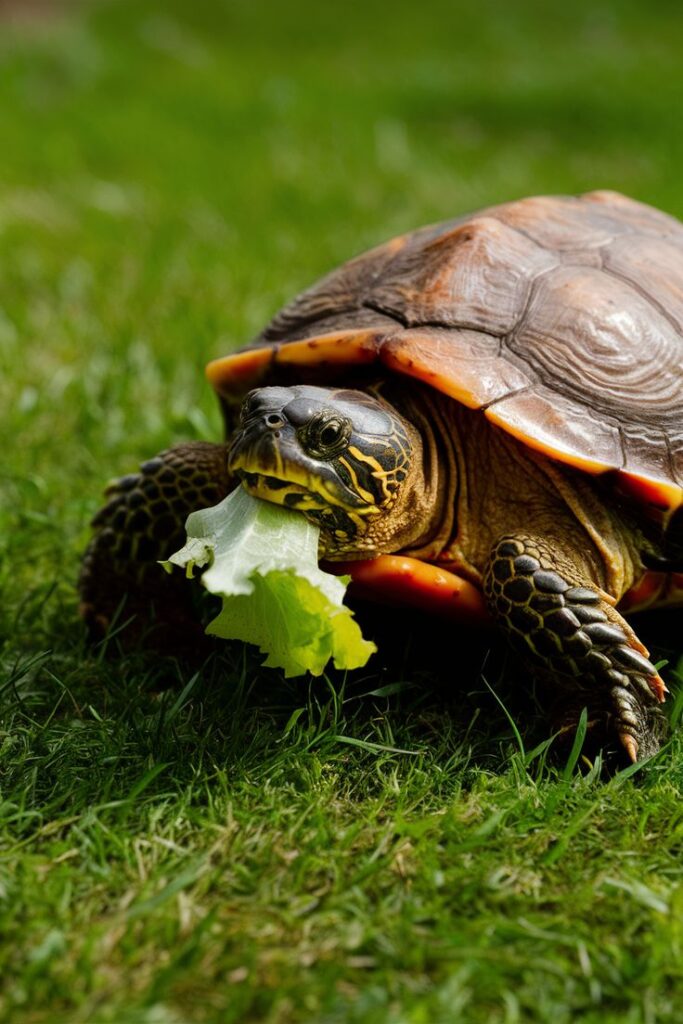
Q: Which turtle species shows the widest range of colors?
The diamondback terrapin is one of the most color-diverse species, with individuals ranging from white and cream to dark gray, bluish, or purple skin tones.
Q: Do male and female turtles have different colors?
Not always, but in some species, males may appear darker while females may be lighter. Coloration can sometimes be a subtle clue to sex differences.
Q: What color patterns make painted turtles unique?
Painted turtles are famous for their bright yellow stripes and bold red markings along their shells and skin, making them one of the most colorful freshwater turtles.
Q: Can turtles be completely black or completely white?
Yes. Some turtles are almost entirely black, while rare albino turtles can appear nearly white or pale cream.
Q: Why do some turtles have stripes or spots on their shells?
Stripes and spots serve as camouflage in their environments, helping turtles blend into water plants, sand, or rocky areas.
Q: How do turtle colors help protect them from predators?
Turtle colors work as natural camouflage, making it harder for predators to spot them in oceans, rivers, or forests.
Q: Do environmental factors affect turtle color shades?
Yes. Sun exposure, diet, and water quality can slightly influence a turtle’s skin or shell shade, making it lighter or darker over time.
Q: Can the sun or water quality change a turtle’s color?
Yes. Prolonged sunlight can darken shells, while poor water quality may cause discoloration or dullness in a turtle’s appearance.
Q: Do albino turtles exist and what color are they?
Yes, albino turtles exist. They are usually white, pale yellow, or pinkish, with red or light-colored eyes.
Q: Are turtle colors important for species identification?
Yes. Researchers often identify turtle species by shell color, skin stripes, or specific markings, especially in similar-looking subspecies.
Q: What colors do diamondback terrapins usually display?
Diamondback terrapins can appear in light cream, dark gray, bluish, or purplish skin tones, often with unique speckled shell patterns.
Q: How can you tell turtle species apart by color?
Each turtle species has distinct coloration—green sea turtles are olive-green, painted turtles are red/yellow striped, and leatherbacks are black with white spots.
Q: What color variations are seen in snapping turtles?
Snapping turtles are usually dark brown, gray, or black, often with rough textures and muted camouflage-friendly shades.
Q: Which sea turtle has the darkest shell color?
The leatherback sea turtle has the darkest shell, typically black with white splotches.
Q: Are turtle plastrons (bottom shells) a different color from the top?
Yes. The plastron is often lighter than the carapace, ranging from yellow, cream, or white with darker patches in some species.
Q: Can diet affect the color of a turtle’s skin or shell?
Yes. Nutrient deficiencies or excesses can sometimes cause faded or discolored shells, while healthy diets support vibrant pigmentation.
Q: What colors are found in rare genetic mutations of turtles?
Mutations can produce blue, purple, pink, or albino white shells and skin, though these are extremely rare in the wild.
Q: How do turtle shell colors appear under water?
Underwater, olive-green, brown, and black shells often look darker, while yellow or red stripes shimmer against sunlight in shallow water.
Q: Do all turtles have some green coloration?
No. While many turtles have green shells or skin, some are primarily black, gray, brown, or cream without visible green.
Q: Can turtles have multi-colored shells?
Yes, especially species like the painted turtle, which may show brown shells with red, yellow, and black patterns.
Q: Which turtle has the most colorful shell patterns?
The painted turtle is considered one of the most colorful, with red, yellow, orange, and black designs on its shell.
Q: What is the difference between tortoise and turtle colors?
Tortoises are usually brown, tan, or gray, while turtles show more variety with greens, blacks, olive, and brighter stripes in aquatic species.
Q: Do turtle hatchlings have brighter colors than adults?
No, hatchlings are often darker (almost black), while adults develop olive-green, brown, or patterned shells as they mature.
Q: Are turtle eye colors related to their skin colors?
Not directly. Some turtles have red, orange, or brown eyes, while their skin may be green, gray, or striped.
Q: Can turtle shell color indicate health or illness?
Yes. Faded, discolored, or soft shells may indicate poor diet or illness, while vibrant shell colors often reflect good health.
Q: What colors are most attractive to turtles in their environment?
Turtles don’t see color the same way humans do, but studies suggest they react strongly to bright reds, yellows, and greens.
Q: Do different turtle habitats influence their colors?
Yes. Forest turtles tend to be brown or green, while desert tortoises are usually tan or gray. Sea turtles show olive-green or reddish-brown tones suited for ocean camouflage.
Q: What colors are box turtles?
Box turtles often have dark brown shells with yellow or orange patterns, giving them a mosaic-like appearance.
Q: What colors are snapping turtles?
Snapping turtles are mostly dark brown, black, or gray, with rough textures that help them blend into muddy waters.
Q: What color are loggerhead sea turtles?
Loggerhead sea turtles have reddish-brown shells with yellow plastrons and pale skin.
Q: What color are hawksbill sea turtles?
Hawksbill turtles have amber-colored shells with streaks of brown, black, and gold, often appearing mottled.
Q: What color are Kemp’s ridley sea turtles?
Kemp’s ridleys are usually olive-gray, both on their shells and skin, with lighter undersides.
Q: What color are olive ridley sea turtles?
As their name suggests, olive ridleys are olive-green to grayish-brown, with lighter yellow undersides.
Q: What colors are found in red-eared sliders?
Red-eared sliders are known for their green shells and the distinct red stripe near their ears.
Q: What color are painted turtles?
Painted turtles are very colorful, with olive to black shells decorated with bright red and yellow markings.
Q: What colors are softshell turtles?
Softshell turtles usually have olive, gray, or brown shells, often smooth and leathery with dark spots.
Q: What colors are musk turtles?
Musk turtles are typically dark brown or black, with some having faint yellow striping on their heads.
Q: What colors are map turtles?
Map turtles get their name from their olive or greenish shells, covered in yellow lines resembling maps.
Q: What color is the rare albino turtle?
Albino turtles are usually white, pale yellow, or pinkish, with striking red or light-colored eyes.
Q: Do turtles look different colors in sunlight?
Yes, in direct sunlight their shells may look lighter or shinier, while underwater or in shade they appear darker.
Q: Do turtles look different at night?
At night, turtles appear much darker, since low light reduces the visibility of their bright markings.
Q: Can turtle shell color fade?
Yes, shell color may fade with age, poor diet, or health problems, making them look duller.
Q: Do turtles ever glow or shimmer under light?
Some shells, especially painted turtles, can shimmer under sunlight or water reflections, but they do not glow naturally.
Q: Are turtle shell colors used for scientific studies?
Yes, researchers often study shell color variations to identify species, age, health, and genetic diversity.
Q: Can turtle shell patterns be used for identification?
Yes. Just like fingerprints, patterns on shells are unique and often used to track individual turtles.
Q: Are sea turtle shells darker than freshwater turtles?
Yes. Sea turtles usually have darker shells like black or olive-green, while freshwater turtles often show brighter yellows and reds.
Q: Can two turtles of the same species have different colors?
Yes, individual variation is common. Even within one clutch, turtles may range from light cream to dark gray.
Q: Are turtle colors linked to age?
Yes. Hatchlings are darker while adults lighten or develop patterned shells as they age.
Q: Are turtle colors linked to diet?
Yes. A healthy diet maintains vibrant shell colors, while poor nutrition can cause faded or patchy tones.
Q: Do turtles use colors for mating?
In some species, bright colors on the head or limbs play a role in attracting mates.
Q: Do turtle eye colors vary by species?
Yes. Turtles can have brown, orange, red, or yellow eyes, often different from their shell or skin colors.
Q: Do turtles in colder climates have different colors?
Yes. Turtles in colder regions often appear darker, which helps them absorb more heat from the sun.
Q: Can turtles be pink?
Yes, though very rare. Some albino or mutated turtles may appear pinkish due to pigmentation issues.
Q: Are turtle plastrons always lighter than their shells?
Usually yes. Plastrons are commonly yellow, cream, or white, contrasting with the darker top shell.
Q: Which turtle has the most beautiful colors?
The painted turtle and hawksbill sea turtle are often considered the most beautiful for their bright, patterned shells.
Q: Do turtle shell colors tell their geographic origin?
Yes, regional adaptations mean turtles from different habitats may show distinct colors and markings.
Q: Are turtle colors permanent?
Not entirely. While genetic colors remain, external factors like sunlight, water quality, and age can change shades.
Q: Can turtle shells develop unusual colors from illness?
Yes. Shell rot or fungal infections can cause white, gray, or discolored patches.
Q: Do turtles see colors the same way humans do?
Research suggests turtles can perceive a wide range of colors, possibly more vividly than humans in some cases.
Q: Are turtle colors important in conservation?
Yes. Conservationists use shell and skin coloration to study population health and survival rates.
Q: Do turtle shell colors inspire human design?
Yes. Fashion, jewelry, and art have long been inspired by the mottled patterns of turtle shells (though now protected).
Pingback: Can Turtles See in the Dark? 7 Surprising Facts You Need to Know